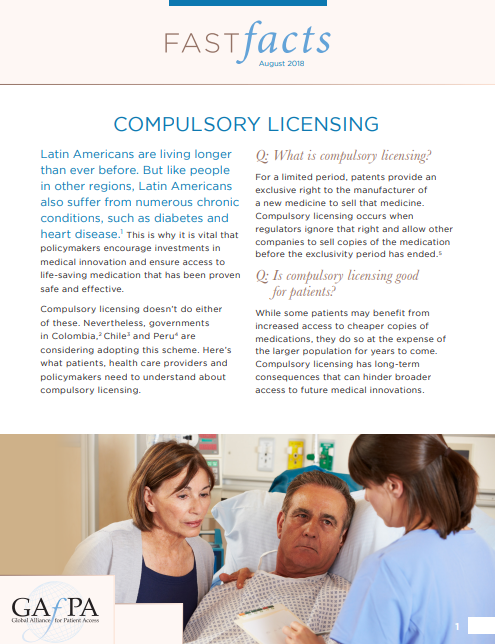
But how does compulsory licensing work? And does it really meet patients’ needs?
Compulsory licensing occurs when governments override the patent protection on an innovative medicine, allowing other companies to sell copies of the medicine before the period of exclusivity on the original has expired. The move is designed to get quick, affordable medicine for a large group of patients. And it’s a timely topic in Latin America, where nations like Colombia, Chile and Peru are considering issuing compulsory licenses.
But the concept doesn’t always play out as intended.
In Brazil, GAfPA’s “Fast Facts” notes, it took two years from the time compulsory licenses were issued for patients to actually access the medicines produced. Anticipated cost savings are another issue. GAfPA’s “Fast Facts” explains that, in one case, medications produced under a compulsory license wound up costing 25 percent more than the original.
Then there are safety concerns. Though compulsory licensing gives companies permission to create copies of existing medications, it does not transfer to those companies information about production or quality. Nor does it ensure the capacity to create the medicine to scale. And because of the emphasis on getting medications to patients quickly, drugs created under compulsory licenses may not have been held to the same level of scrutiny as those approved under traditional means by the Food and Drug Administration or the European Medicines Agency.
Governments lured by the promise of fast, cheap medicine may also overlook the long-term impact of compulsory licensing. GAfPA’s “Fast Facts” explains that patent exclusivity is a powerful incentive for manufacturers to take on the financial risk of developing new medicines, including therapies for conditions that ail developing nations. When governments grant compulsory licenses, they discourage manufacturers from taking those risks, undermining new treatments and patients’ access to innovative therapies that could one day change, or even save, their lives.
The move can also undercut regional economic development. Companies may prefer to conduct research and clinical trials in countries that honor patent exclusivity agreements. That leaves patients in other countries without the economic investment and local health services that clinical research can provide.
What’s a better option? GAfPA’s “Fast Facts” points to voluntary licensing, an arrangement whereby patent holders willingly partner with other companies to make, import or sell a drug that’s still under patent. Built on collaboration, these arrangements can avoid both the patient safety and the long-term ramifications of compulsory licensing.
To learn more about compulsory licensing and its effects on Latin America, read GAfPA’s “Fast Facts,” available in English and Spanish.
Recent Posts

Global Alliance for Patient Access
© 2025 GAfPA. All Rights Reserved
| Cookie | Duration | Description |
|---|---|---|
| cookielawinfo-checkbox-analytics | 11 months | This cookie is set by GDPR Cookie Consent plugin. The cookie is used to store the user consent for the cookies in the category "Analytics". |
| cookielawinfo-checkbox-functional | 11 months | The cookie is set by GDPR cookie consent to record the user consent for the cookies in the category "Functional". |
| cookielawinfo-checkbox-necessary | 11 months | This cookie is set by GDPR Cookie Consent plugin. The cookies is used to store the user consent for the cookies in the category "Necessary". |
| cookielawinfo-checkbox-others | 11 months | This cookie is set by GDPR Cookie Consent plugin. The cookie is used to store the user consent for the cookies in the category "Other. |
| cookielawinfo-checkbox-performance | 11 months | This cookie is set by GDPR Cookie Consent plugin. The cookie is used to store the user consent for the cookies in the category "Performance". |
| viewed_cookie_policy | 11 months | The cookie is set by the GDPR Cookie Consent plugin and is used to store whether or not user has consented to the use of cookies. It does not store any personal data. |